What Causes Fast-Spinning Pulsar Binary Systems To Switch On And Off? New Observations Provide Clues

When a pulsar and a star get into a relationship, it’s always a cannibalistic one. The pulsar, which is a rotating neutron star, feeds off of gas gravitationally pulled from the companion, eventually turning into a millisecond pulsar that has a rotational period of between 1 and 10 milliseconds.
As a pulsar rotates, it emits high-energy radiation into the cosmic void, similar to a lighthouse casting beams of light. If this beam of high-energy radiation is pointed toward the Earth, the pulsars can be detected using telescopes.
In recent years, astronomers studying these millisecond pulsars (MSPs) have observed that every now and then these objects can “turn off” — stop emitting beams of radiation — and return to a state in which they are once again siphoning off material from their companion. This phenomenon, which can repeat many times, is still not completely understood.
A new study published in the latest edition of the Astrophysical Journal suggests that in many MSP binary systems, the companion star’s strong magnetic field may be responsible for switching the pulsar on and off intermittently. The study, based on observations of one of the fastest-spinning pulsars in our galaxy by a professional astrophysicist and an amateur astronomer, is also the first to describe the detection of star spots on an MSP’s companion star.
“The dataset was unlike anything I had ever seen,” study co-author John Antoniadis — an astrophysicist at the University of Toronto — said in a statement, referring to the observations made by André van Staden, an amateur astronomer from South Africa.
This MSP, located 2,500 light-years away in the direction of the constellation Sagittarius, consists of a rapidly rotating neutron star and a companion, separated by a distance of just over 1.2 million miles.
When van Staden observed the MSP over a 15-month period, he noticed an unexpected rise and fall in the companion star’s brightness — one that wasn’t in sync with its orbital period.
“Antoniadis and van Staden concluded that this was caused by ‘starspots,’ the equivalent of our Sun’s sunspots, and that the spots were lowering the brightness of the star,” the University of Toronto’s Dunlap Institute for Astronomy & Astrophysics explained in the statement. “What’s more, the spots were much larger relative to the companion star’s diameter than our Sun’s sunspots.”
The existence of a strong magnetic field was itself inferred from the presence of these starspots.
The researchers suggest that this magnetic field — rather than the pulsar’s stellar wind and radiation — may be turning off the MSP, creating asymmetrical optical light curves.
© Copyright IBTimes 2024. All rights reserved.












